UNIT 3
FACTs Technology
1. What are the problems of AC transmission?
In AC power systems because of the insignificant electrical storage, the electrical generation and load must balance at all times.
To some extent the electrical system is self-regulating- if generation is less than the load, the voltage and frequency drop, and thereby the load goes down to equal the generation minus the transmission losses. However, there is only a few percent margin for search self-regulation.
Voltage collapse problem- If the voltage is supported with the reactive power support, then the load will go up, and consequently the frequency will keep dropping and then the system will collapse. Alternatively, if there is inadequate reactive power the system can have voltage collapse.
Surplus generation power flow problem- When surplus generation is available, it can flow towards the area where there is deficiency in generation. This happens without any control power, flow is based on the inverse of the various transmission line impedances bus stop apart from ownership and contractual issues over the line which carry how much power coma it is likely that the lower impedance line may become overloaded and thereby limit the loading on both parts even though the higher impedances path is not fully loaded.
2. What are the solutions for AC transmission?
Consider a very simple case of power flow shown in figure (a), two parallel paths from a Surplus generation area, an equivalent generator on left, to a deficit generation area on the right, without any control power flow is based on the inverse of the various transmission line impedances.
Alternative FACTS controllers(figure b) and (figure c) show one of the transmission lines with different types of series type FACTS controller. By means of controlling impedance (figure b) for phase angle (figure c) or series injection of appropriate voltage FACTS controller can control the power flow as required maximum power flow can in fact be limit to its rated limit under contingency conditions when this line is expected to carry more power due to the loss of parallel lines.
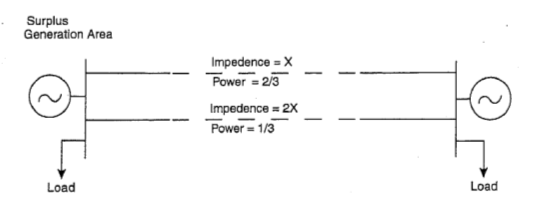
Fig. (a)

Fig. (b)

Fig. (c)
3. Explain the evolution of facts technology?
The FACTS technology is not a single high-power controller, but rather a collection of controllers, which can be applied individually or in coordination with others to control one or more of inter-related system parameters.
FACTS Technology extends itself to usable transformation limits in the step-by-step manner with the incremental investment as and when required.
Some of the power electronics controllers, now used and converted into the FACTS concept lead the introduction of the FACTS concept.
The shunt connected static VAR compensator (SVC) for voltage control which was first demonstrated in Nebraska and commercialized BY GE in 1974 and by Westinghouse in Minnesota in 1975.
The first series connected controller,NGH-SSR damping scheme, a low power series capacitor impedance control scheme, was demonstrated in California by Siemens in 1984. It showed that with an active controller there is no limit to series capacitor compensation.
Even prior to SVCs, there are two versions of static saturable reactors for limiting over voltages and also powerful gapless metal oxide arresters for limiting dynamic voltage.
4. Explain the development of FACTS controller?
The development of FACTS controllers has followed two different approaches.The first approach employs reactive impedances or a tap changing transformerwith thyristor switches as controlled elements, the second approach employsself-commutated static converters as controlled voltage sources. Ln general, FACTS controllers can be divided into four categories.(i) series (ii) shunt (iii) combined series-series(iv) combined series-shuntcontrollers.
The general symbol for a FACTS controller is given in Fig.(a). It shows a thyristor arrow inside a box. The series controller of Fig.b couldbe a variable impedance, such as capacitor, reactor, etc. or a power electronicsbased variable source. All series controllers inject voltage in series with theline. If the voltage is in phase quadrature with the line, the series controller onlysupplies or consumes variable reactive power. Any other phase relationship willinvolve real power also.
The shunt controllers of Fig. c may be variable impedance, variablesource or a combination of these. All shunt controllers inject current into thesystem at the point of connection. Combined series-series controllers of Fig.d could be a combination of separateseriescontrollers which are controlledin a coordinated manner or it could be a unified controller.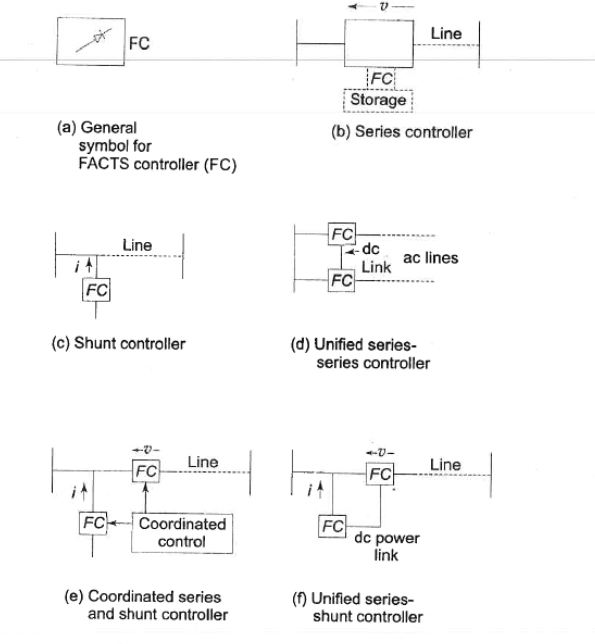
Combined series-shunt controllers are either controlled in a coordinatedmanner as in Fig. e or a unified Power Flow Controller with series andshunt elements as in Fig. f. For unified controller, there can be a real powerexchange between the series and shunt controllers via the dc power link.
The group of FACTS controllers employing switching converter-basedsynchronous voltage sources include the Static synchronous Compensator(STATCOM), the static synchronous series compensator (SSCC), the unifiedpower flow controller (UPFC) and the latest, the Interline Power FlowController (IPFC).
5. What is STATCOM?
STATCOM is a static synchronous generator operated as a shunt-connectedstatic var compensator whose capacitive or inductive output current can be controlled independent of the system voltage. The STATCOM, the SVC, controls transmission voltage by reactiveshunt compensation. It can be based on a voltage-sourced oi current-sourcedconverter. Figure (g), (h) shows a one-line diagram of SATCOM based on avoltage-source converter and a current sourcedconverter. Normally a voltagesourceconverter is preferred for most converter-based FACTS controllers.STATCOM can be designed to be an active filter to absorb system harmonics. 
Fig (g) Fig (h)
A combination of STATCOM and any energy source to supply or absorbpower is called static synchronous generator (SSG).
6. Explain the principle of operation, circuit diagram and applications of SVC?
Static Var compensator (SVC): It is aSeries connected static var generator or absorber whose output is adjusted to exchange capacitive or inductive current so as to maintain control specific parameters of the electrical power system (typically bus voltage).
This is a general term for a thyristor controlled or thyristor switched reactor and or thyristor switched capacitor or combination. SVC is based on thyristor without the gate turn off capability. It includes separate equipment for leading and lagging var, the thyristor controlled or Thyristor switch reactor for absorbing reactive power and thyristor switched Capacitor for supplying reactive power.
Shunt Compensators:
Shunt compensators are connected in shunt at various system nodes (major substations) and sometimes at mid-point of lines. These serve the purposes of voltage control and load stabilization. As a result of installation of shunt compensators in the system, the nearby generators operate at near unity pf and voltage emergencies mostly do not arise. The two kinds of compensators in use are:
(i) Static var compensators (SVC): These are banks of capacitors (sometimes inductors are also used under light load conditions)
(ii) STATCOM: static synchronous compensator:
Static var compensators (SVC):
SVCs are part of the Flexible AC transmission system device family, regulating voltage and stabilizing the system. Unlike a synchronous condenser which is a rotating electrical machine, a "static" VAR compensator has no significant moving parts. Prior to the invention of the SVC, power factor compensation was the preserve of large rotating machines such as synchronous condensers or switched capacitor banks.
These comprise capacitor bank fixed or switched (controlled) or fixed capacitor bank and switched reactor bank in parallel. These compensators draw reactive (leading or lagging) power from the line thereby regulating voltage, improve
Stability (steady state and dynamic), control voltages and reduced voltage flicker. These also reduced voltage and current unbalances. In HVDC application these compensators provide the required reactive power and dump out sub-harmonic oscillations.
Since var compensators use switching for var control. These are also called static var switches or systems.
Basic configuration of SVC: thyristor in antiparallel can be used to switch a capacitor/ Reactor in stepwise control. when the circuitry is designed to adjust the firing angle capacitor/ reactor unit acts as continuously variable in the power circuit.
Capacitor for capacitor and inductor Bank can be varied stepwise or continuously by control of thyristor. Several important SVS configurations have been devised and are applied in shunt compensation. Some of these are saturated reactors, Thyristor control reactors, Thyristor switched capacitors.
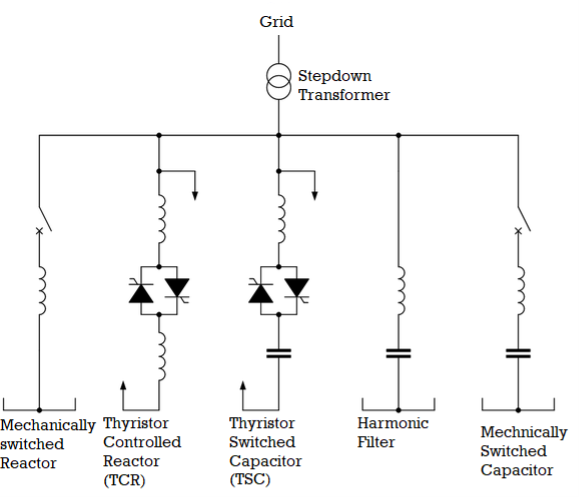
Fig. One-line diagram of a typical SVC configuration
7. Explain STATCOM?
STATCOM: (Static Synchronous Compensator): static generator operated as shunt connected static var compensator whose, capacitive for inductive output current can be controlled independent of the AC system voltage.

Fig. (a) Simple one line diagram of STATCOM (Voltage source converter based and Current source converter based)
STATCOM Is one of the key FACTS controllers. it can be based on a voltage source or current source converter; figure shows a simple one line diagram of a STATCOM based on voltage source converter and a current source converter. from an overall cost point of view, voltage source converters are preferred.
For the voltage source converter, ac output voltage is controlled such that it is just right for the required reactive current flow for any bus voltage DC capacitor voltage is automatically adjusted as required to serve the voltage source for the. Convert STATCOM can be designed to act as an active filter to absorb system harmonics.
STATCOM in power systems is used to increase the power transmission capability with a given transmission network from the generators to the loads. A static constructor cannot generate or absorb real power; the reactive output power of the compensator is varied to control the voltage at given terminals of the transition network so as to maintain desired power flow under possible system disturbances and contingencies.
Typical terminal voltage versus output current characteristic of static compensators with the specific slope is shown in figure below. Together with particular load lines (Voltage versus load current characteristics) of the AC system. Load line one intersects the compensator v-i characteristics at nominal voltage, does the output current of the capacitor is zero. do line to is below line want you to the decrease in the power system voltage (e.g. generator outage). Its intersection with the compensator v-i characteristics calls for the capacitive compensating current Ic2. (e.g. Load rejection). its interconnection with the compensator v-i characteristics define the inductive compensation current Il3. the intersection points of The Road Lines 2 and 3 with the vertical (voltage) axis defined the terminal voltage variation without any compensation. The Terminal voltage variation with the compensation in the linear operating range under steady state condition and slow system changes is entirely determined by the regulations lo which is independent of the type of VR generator used as can be seen in figure below. outside the linear operating range, the STATCOM and SVC are differently as indicated in figure. The dynamic performances of the two types of computer is also different.
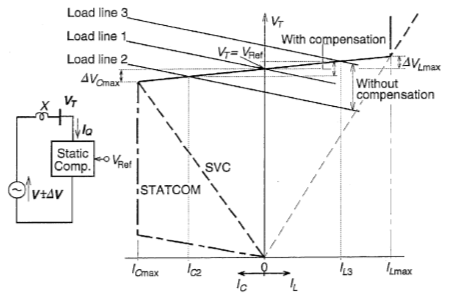
Fig (b): V-I Characteristics of STATCOM and SVC
8. Explain Thyristor controlled series capacitor (TCSC):
Reactance compensator which consists of a series capacitor Bank sheltered by thyristor-controlled reactor in order to provide smoothly variable series capacitive reactance is called as thyristor control series capacitor (TCSC).

Fig. Thyristor controlled series capacitor
The TCSC is based on thyristors without the gate turn off capability. a variable reactor such as a thyristor-controlled reactor (TCR) is connected across a series capacitor. When the TCR firing angle is 180 degrees, the reactor becomes non conducting and the series capacitor is normal. as the firing angle is advanced from 180 degrees to less than 180 degrees, the capacitive impedance increases. At the other end, when the firing angle is 90 degrees, the reactor becomes fully conducting, and the total impedance becomes in the, because the reactor impedance is designed to be much lower than the series capacitor impedance. With 90° firing and, the TCSC health in limiting fault current. The TCSC may be a single large unit, or may consist of several equal or different size smaller capacitors in order to achieve a superior performance.

Fig. Compensating Voltage Vs Line Current and corresponding loss Vs Line current characteristics of TCSC.
TCSC is a variable inductance type series compensator.
TCSC can maintain maximum compensating voltage with a decreasing line current over a control range determined by the current boosting capacity of the thyristor-controlled reactor.
The TCSC employ conventional thyristors (with no internal turn off capability). And these have the highest current and voltage ratings and also highest surge current capability.
At rated line currents the losses of the reactors are around 0.5% can be seen in fig above.
9. Explain UPFC?
A combination of static synchronous compensator(STATCOM) and static series compensator (SSSC) which are coupled via a common DC link, to allow bi directional flow of real power between the series output terminals of the SSSC and the shunt output terminals of the STATCOM, and are controlled to provide concurrent real and reactive series line compensation without an external electrical energy source. The UPFC by means of angularly unconstrained series voltage injection, is able to control, concurrently or selectively, that transmission line voltage, impedance and angle or, alternatively, the real and reactive power flow in the line. UPSC may also provide independently controllable shunt reactive compensation.
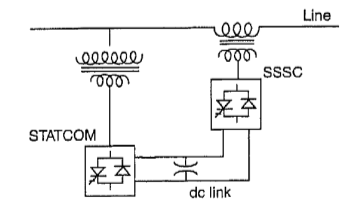
Fig. (a) UPFC
In UPFC figure shown above, it combines a STATCOM and an SSSC, the active power for series unit SSSC is obtained from line itself via the shunt unit STATCOM; the letter is also used for voltage control of its reactive power. This is a complete controller for controlling active and reactive power control through a line, as well as line voltage control.
Additional storage such as superconducting magnet connected to the DC link wires and electronic industries would provide the means of further enhancing the effectiveness of UPFC. the controlled exchange of real power with an external source, such as storage, it is much more effective in control of system dynamics than modulation of the power transfer within a system.

Fig.(b) UPFC by using two back to back voltage source converters.
In the figure shown below UPFC consists of two voltage source converters. This back to back converters, labelled as converter 1 and converter 2 in figure, are operated from a common DC link provided by a DC storage capacitor. This arrangement functions as an ideal AC to AC power converter in which the real power can freely flow in either direction between the AC terminals of the two converters, and each converter can independently generate or absorb reactive power at its own AC output terminal.
Converter 2 provides the main function of UPFC (by injecting a voltage Vpq with controllable magnitude Vpq) in series with the line wire and insertion transformer. This injected voltage acts essentially as a synchronous AC voltage source. The transmission line current flows through this voltage source resulting in the reactive and real power exchange between IT and the AC system. The reactive power exchanged at the terminal is generated internally by the converter. The real power exchange at ac terminal is converted into DC power which appears at the DC link as positive or negative real power demand.
10. Explain the comparison between STATCOM and SVS:
The basic operational difference renders the STATCOM to have
- Overall superior functional characteristics
- Better for performance
- Performance and greater application flexibility as compared to SVC.
- The ability of the STATCOM to maintain full capacity output current at low system voltage also makes it more effective than SVC in improving the transient (first swing) stability.